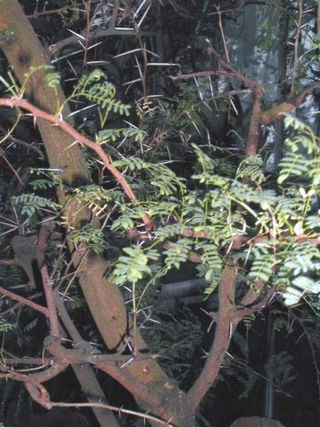
Vachellia horrida is a low spreading shrub or sometimes tree native to both the wet and dry scrublands of tropical to subtropical East Africa. Common names for it are Cape gum, Karroo Thorn and dev-babul. It is also found elsewhere in Africa, Asia, India and South America. It frequently has stipular spines 9.5 cm long. V. horrida is an important browse plant in the tropics, particularly during the dry season.

Vachellia karroo, (synonym Acacia karroo} commonly known as the sweet thorn, common acacia, Karoo thorn, Cape gum or cockspur thorn, is a species of Vachellia, in the Mimosa sub-family of the Fabaceae or pea family, which is native to southern Africa from southern Angola east to Mozambique, and south to South Africa.

Botryosphaeria dothidea is a plant pathogen that causes the formation of cankers on a wide variety of tree and shrub species. It has been reported on several hundred plant hosts and on all continents except Antarctica. B. dothidea was redefined in 2004, and some reports of its host range from prior to that time likely include species that have since been placed in another genus. Even so, B. dothidea has since been identified on a number of woody plants—including grape, mango, olive, eucalyptus, maple, and oak, among others—and is still expected to have a broad geographical distribution. While it is best known as a pathogen, the species has also been identified as an endophyte, existing in association with plant tissues on which disease symptoms were not observed. It can colonize some fruits, in addition to woody tissues.

The Botryosphaeriaceae are a family of sac fungi (Ascomycetes), which is the type representative of the order Botryosphaeriales. According to a 2008 estimate, the family contains 26 genera and over 1500 species. Members of this order include notable plant pathogens.

Platypleura is a genus of cicadas that occurs widely across Africa and southern Asia. Some of the South African species are remarkable for their endothermic thermoregulation that enables crepuscular signalling, an adaptation that reduces risk of predation and enables a greater range for their calls. In field experiments their maximum body temperature while calling at dusk, was measured at 22 °C above ambient temperature.

Vachellia is a genus of flowering plants in the legume family, Fabaceae, commonly known as thorn trees or acacias. It belongs to the subfamily Mimosoideae. Its species were considered members of genus Acacia until 2009. Vachellia can be distinguished from other acacias by its capitate inflorescences and spinescent stipules. Before discovery of the New World, Europeans in the Mediterranean region were familiar with several species of Vachellia, which they knew as sources of medicine, and had names for them that they inherited from the Greeks and Romans.

Senegalia caffra, also known as hook-thorn or Acacia caffra, is a tree that occurs commonly in southern Africa. Though it is cultivated, it often occurs naturally in Gauteng suburban gardens, together with Acacia karroo and Acacia robusta.
Neofusicoccum australe is a fungus species in the genus Neofusicoccum. It is responsible for a grapevine trunk disease.
Aplosporella yalgorensis is an endophytic fungus that might be a canker pathogen, specifically for Eucalyptus gomphocephala. It was isolated from said trees in Western Australia.
Pseudofusicoccum adansoniae is an endophytic fungus that might be a canker pathogen, specifically for Adansonia gibbosa (baobab). It was isolated from said trees, as well as surrounding ones, in the Kimberley.
Pseudofusicoccum ardesiacum is an endophytic fungus that might be a canker pathogen, specifically for Adansonia gibbosa (baobab). It was isolated from said trees, as well as surrounding ones, in the Kimberley.
Pseudofusicoccum kimberleyense is an endophytic fungus that might be a canker pathogen, specifically for Adansonia gibbosa (baobab). It was isolated from said trees, as well as surrounding ones, in the Kimberley.
Neoscytalidium novaehollandiae is an endophytic fungus that might be a canker pathogen, specifically for Adansonia gibbosa (baobab). It was isolated from said trees, as well as surrounding ones, in the Kimberley.
Lasiodiplodia margaritacea is an endophytic fungus that might be a canker pathogen, specifically for Adansonia gibbosa (baobab). It was isolated from said trees, as well as surrounding ones, in the Kimberley.
Fusicoccum ramosum is an endophytic fungus that might be a canker pathogen, specifically for Adansonia gibbosa (baobab). It was isolated from said trees, as well as surrounding ones, in the Kimberley.
Dothiorella longicollis is an endophytic fungus that might be a canker pathogen, specifically for Adansonia gibbosa (baobab). It was isolated from said trees, as well as surrounding ones, in the Kimberley.
Diplodia allocellula is an endophytic fungus that might be a latent pathogen. It was found on Acacia karroo, a common tree in southern Africa.
Dothiorella dulcispinae is an endophytic fungus that might be a latent plant pathogen. It was found on Acacia karroo, a common tree in southern Africa.
Dothiorella brevicollis is an endophytic fungus that might be a latent plant pathogen. It was found on Acacia karroo, a common tree in southern Africa.
Spencermartinsia pretoriensis is an endophytic fungus that might be a latent pathogen. It was found on Acacia karroo, a common tree in southern Africa.






